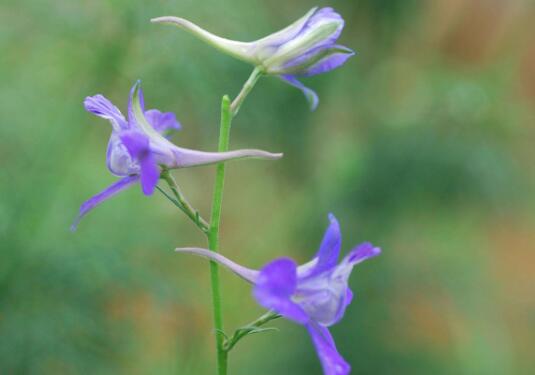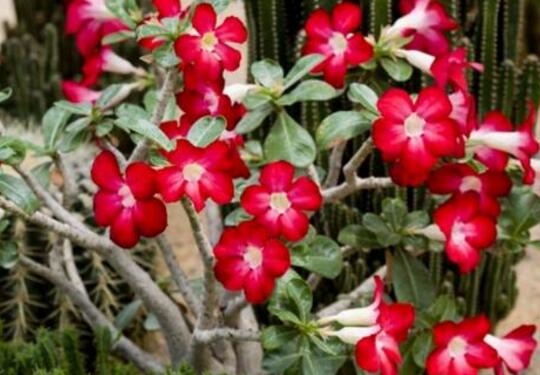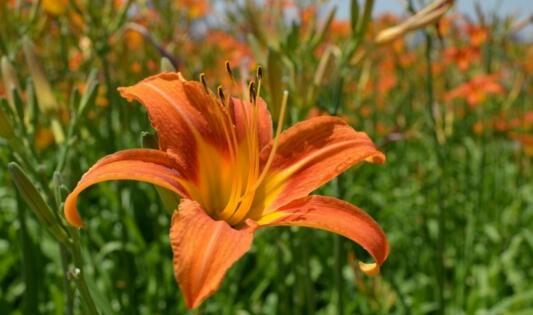What about the growth of swallows? pest control of swallows / 2 insect pests 2 diseases
In the process of breeding swallows, people are most afraid of such problems as diseases and insect pests, which do great harm to plants, which can easily lead to plant death if they are not dealt with in time. What about the swallow worms? How to control the diseases and insect pests of delphinium? Next, the editor will take you to learn about it.
First, what to do with the long worm of delphinium

If you want to know what to do with delphinium worms, we first need to know what kind of worms grow, so that we can deal with them pertinently, because the treatment of each kind of diseases and insect pests is different. The details are introduced in the following column of pest control of delphinia. Let's take a look.
II. Pest control of swallowgrass
Insect pest
1. Night E
Yue is a kind of insect of Lepidoptera, its volume is very small, its body length is generally between 28 and 32mm, and its color is mostly grayish brown. Among the diseases and insect pests of delphinium, this pest mainly harms its leaves. It will gradually gnaw on the mesophyll of delphinium, which leads to the damage of leaves and early shedding, which is very beautiful.
Control method: the reproduction ability of this pest is very strong, so we must deal with it in time. Generally, we can use 2.5% trichlorfon powder to spray and kill the pest.
two。 Aphids
Among the diseases and insect pests of delphinium, aphids are one of the most common pests, which do great harm to delphinium, and gradually absorb the sap of the plant, resulting in the loss of nutrients and the phenomenon of death.
Prevention and control methods: when aphids are found, we must deal with them in time, and we can use 1000 times of marathon emulsion to spray delphinium, so as to kill aphids.
Disease
1. Powdery mildew
Among the diseases and insect pests of delphinium, powdery mildew is a kind of disease with high incidence. During the disease, there will be many white dust-like mildew spots on the leaves of delphinium, which will inhibit the growth of delphinium and gradually lead to the phenomenon of leaf atrophy and shedding.
Control method: in the prevention and control of this disease, we can use 15% rust rather wettable powder 800-1000 times to spray delphinium, usually spray once every 5-7 days, and then recover after 2-3 times.
two。 Black spot disease
Black spot disease is harmful to the whole plant of delphinium. During the disease, there will be many black spots on the leaves of delphinium, and will gradually spread with the passage of time, resulting in the gradual death of the plant.
Prevention and treatment: for this disease, we can use streptomycin 1000-fold liquid spray to spray delphinium, usually once every 10-15 days, and can be basically cured after 1-2 times.
Summary of common diseases and insect pests and control methods of swallow grass
Delphinium needs a sunny and cool growing environment. It can withstand both cold and drought, but it is not resistant to high temperature and moisture. Under the condition of high temperature and wet water, it is easy to cause diseases and insect pests. What are the kinds of diseases and insect pests? How to prevent and cure?
Common disease of swallows: powdery mildew
Symptoms of onset
The disease harms the leaves and stems of plants. At the initial stage of the disease, white powdery mildew spots appeared in the disease part of the susceptible plants. when the disease was serious, the young leaves and shoots curled and the growth was inhibited. In the later stage of the disease, small black particles were formed in the mildew spots, which was the closed capsule of the pathogen.
Morbidity regularity
The pathogen overwintered with ascomycetes and produced conidia and ascospores in the spring of the following year. The spores were transmitted by wind and rain and infected and harmed the host. The disease is serious in the damp and cool season.
Prevention and cure method
Reduce the source of infection: after the end of flowering, burn the diseased plants and remnants.
Strengthen cultivation management: the planting land should pay attention to drainage to prevent moisture. The plant is not too dense, maintain good ventilation and light transmission conditions.
Chemical control: spray 1000 times of 50% benzoate wettable powder or 800 times of 50% benzoate wettable powder at the time of onset. The root and neck rot of delphinium is a destructive disease of delphinium. The pathogen invades the plant from the root and root neck, cutting off the water supply, resulting in sudden wilting and death of the plant.
Common disease of swallows: black spot
Symptoms of onset
The disease harms leaves, petioles, stems and flowers of plants, mainly leaves. The disease often occurs first in the lower leaves of the plant. There are shiny black spots on the front of the susceptible leaves, and the disease spots are irregular. The leaf back disease is light brown.
Morbidity regularity
The pathogenic bacteria overwintered on the soil surface or diseased leaves. When the conditions were suitable in the spring of the following year, the pathogens were transmitted through Rain Water and invaded from the host stomata. Seeds can also carry bacteria to spread disease. There are many Rain Water, and the disease is more serious under the condition of moist soil.
Prevention and cure method
Manual removal: when diseased leaves are found, remove and burn them immediately, and cut off the old stems in autumn.
Drug control: when you get sick, you can use streptomycin 1000 times liquid spray.
That's all I know about delphinium today. I hope it will be helpful for flower friends to read this article. If you want to know more about delphinium, please continue to pay attention to the succulent flower bed, we will provide you with more related knowledge!
Common diseases of swallows and their control methods
Common disease of swallows: powdery mildew
Symptoms of onset
The disease harms the leaves and stems of plants. At the initial stage of the disease, white powdery mildew spots appeared in the disease part of the susceptible plants. when the disease was serious, the young leaves and shoots curled and the growth was inhibited. In the later stage of the disease, small black particles were formed in the mildew spots, which was the closed capsule of the pathogen.
Morbidity regularity
The pathogen overwintered with ascomycetes and produced conidia and ascospores in the spring of the following year. The spores were transmitted by wind and rain and infected and harmed the host. The disease is serious in the damp and cool season.
Prevention and cure method
Reduce the source of infection: after the end of flowering, burn the diseased plants and remnants.
Strengthen cultivation management: the planting land should pay attention to drainage to prevent moisture. The plant is not too dense, maintain good ventilation and light transmission conditions.
Chemical control: spray 1000 times of 50% benzoate wettable powder or 800 times of 50% benzoate wettable powder at the time of onset. The root and neck rot of delphinium is a destructive disease of delphinium. The pathogen invades the plant from the root and root neck, cutting off the water supply, resulting in sudden wilting and death of the plant.
Common disease of swallows: black spot
Symptoms of onset
The disease harms leaves, petioles, stems and flowers of plants, mainly leaves. The disease often occurs first in the lower leaves of the plant. There are shiny black spots on the front of the susceptible leaves, and the disease spots are irregular. The leaf back disease is light brown.
Morbidity regularity
The pathogenic bacteria overwintered on the soil surface or diseased leaves. When the conditions were suitable in the spring of the following year, the pathogens were transmitted through Rain Water and invaded from the host stomata. Seeds can also carry bacteria to spread disease. There are many Rain Water, and the disease is more serious under the condition of moist soil.
Prevention and cure method
Manual removal: when diseased leaves are found, remove and burn them immediately, and cut off the old stems in autumn.
Drug control: when you get sick, you can use streptomycin 1000 times liquid spray.
- Prev

Prevention of desert rose diseases and insect pests, environmental ventilation and dry air is the key to prevention.
When planting desert roses, although diseases and insect pests are rare, flower lovers should also fully understand and avoid being at a loss when there are diseases and insect pests, otherwise it will not only slow the growth of desert roses, but also lead to their non-flowering or death of the whole plant. Let's learn about the prevention and control methods of desert rose diseases and insect pests.
- Next

Pest control of day lilies, 3 insect pests / 3 diseases / environmental hygiene is the key to prevention.
Hemerocallis is easy to feed, but it may also be threatened by diseases and insect pests, especially when Hemerocallis is not cultured properly, some germs and pests may appear on Hemerocallis, causing the leaves of Hemerocallis to wither and fall off. Today, let's learn about the pest control methods of Hemerocallis. Statistics of disease and pest control of Hemerocallis showed that
Related
- Fuxing push coffee new agricultural production and marketing class: lack of small-scale processing plants
- Jujube rice field leisure farm deep ploughing Yilan for five years to create a space for organic food and play
- Nongyu Farm-A trial of organic papaya for brave women with advanced technology
- Four points for attention in the prevention and control of diseases and insect pests of edible fungi
- How to add nutrient solution to Edible Fungi
- Is there any good way to control edible fungus mites?
- Open Inoculation Technology of Edible Fungi
- Is there any clever way to use fertilizer for edible fungus in winter?
- What agents are used to kill the pathogens of edible fungi in the mushroom shed?
- Rapid drying of Edible Fungi

